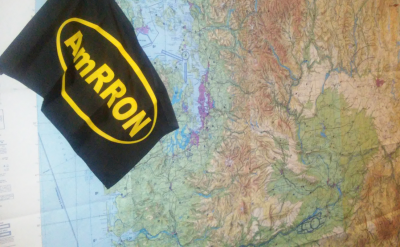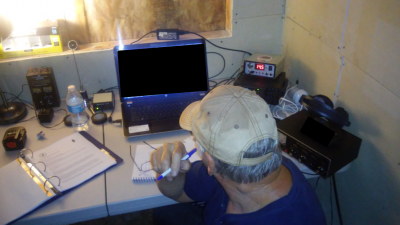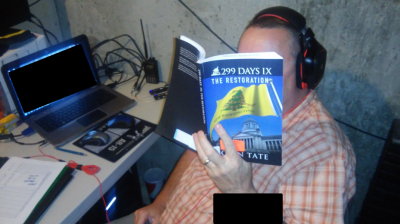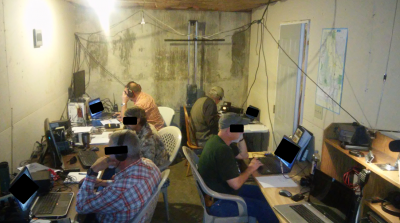Glossary of Terminology:
SIGINTEX = Signals Intelligence Exercise – Training exercise involving monitoring radio traffic to stay informed about a situation
SIGCEN = Signals Center – A temporary or permanent facility where operations related to communications are conducted. Often referred to as a COMCEN.
I/C = Intercept & Collect – Monitoring/Listening for communications and documenting what you hear or see.
ARES = Amateur Radio Emergency Service (The emergency communications branch of the Amateur Radio Relay League)
SET = Simulated Emergency Test
PIR = Priority Intelligence Requirements – Identifies the most important thing to focus on, or the thing we need to know the most.
QSO = ‘Q’ code meaning a two-way exchange over radio between two or more stations.
THE MISSION: Operation Moscow Lab – To establish a centralized SIGCEN staffed with as many AmRRON Corps operators as possible and monitor all communications related to the ARES SET exercise. The exercise required 24-hour monitoring from noon (Saturday) to noon (Sunday). The team began arriving at the facility prior to 0900hrs and was operational, monitoring as early as 1000hrs. Although it was planned to have shifts and reduce the team to minimal manning during the early morning hours, all operators chose to continue monitoring through the night.
THE OBJECTIVE: Practice monitoring and documenting the communications traffic of a network not associated with AmRRON, and organize the information as it is collected. This was accomplished using a centralized SIGCEN fully staffed with ## AmRRON Operators, as well as remote AmRRON I/C stations throughout the area of operations. The focus of the SIGINT teams was the radio traffic from the Idaho ARES SET, which included multiple Idaho counties as well as several counties from Washington state. The primary organizing ARES team for the SET was located in Latah County, near the city of Moscow, ID.
PIR (Priority Intelligence Requirements):
A) Determine what the emergency is, and the circumstances surrounding the unfolding event.
B) Identify stations operators and determine locations, and the scope of the incident (how large of an area is affected?)
C) Determine the chain of command and hierarchy of the communications network and the agencies/organizations being supported by the network.
D) Determine the jurisdictional agency/organization. (Who is calling the shots)
E) Track relief efforts and determine possible future courses of action by relief agencies and government entities responding to the disaster
SIGCEN Capabilities:
HF Voice (Mulitiple simultaneous frequency monitoring)
HF Digital (Multiple simultaneous frequency monitoring)
HF CW (Morse Code) monitoring station (single dedicated station)
VHF/UHF Analog – Amateur radio, linked repeaters, CB, FRS, MURS, emergency services, etc. (Two stations)
SDR – to decode P-25 for monitoring emergency services (Police/Fire), aircraft, amateur radio, commercial businesses, etc. (Single dedicated station)
Scanners – There were four scanners in the SIGCEN, each with a different purpose. Some of their purposes overlapped. We could have used more external antennas to string outdoors. The P25 decoding was an amazing feature (mandatory), and the ‘Close Call’ features are a MUST to look for.
Internet – for QRZ lookups, real-world news reports, email, etc.
NARRATIVE:
The centralized SIGCEN I/C exercise was a huge success from the AmRRON operators’ perspectives. Although it may not be practical (or safe) for most real-world situations, having multiple operators at one location was extremely beneficial for the purposes of this exercise, especially given that it was only a training exercise. This allowed for a fully-staffed SIGCEN to monitor all the bands and modes simultaneously. The close proximity of the operators made it efficiently possible to make changes in duties and responsibilities, provide instant feedback, and implement immediate changes when needed, and to direct the focus of monitoring efforts where they were needed.
Other benefits were that no communications outside the SIGCEN were necessary. In a real-world national emergency, coordinating multiple I/C stations could be cumbersome, slow, and less timely. Also, in a hostile environment (such as invasion by a foreign military), necessary coordination between stations could be inherently dangerous as the could more easily be intercepted. This is true whether using internet, wireless radio communications, or even couriers. So, in some respects it was a very secure environment. This was operated as a ‘Silent Station’ SIGCEN. No transmitting was done from the I/C locations. The only exception was the use of encrypted email.
Drawbacks — In a real-world situation just traveling with such communications equipment may be detrimental to the equipment or the operator, depending on the threat situation. Also, handling and transporting gear and computers increases the risk of damage to equipment. If amateur radio equipment, or other communications gear, were deemed to be ‘contraband’ by an occupying regime (for example), getting caught with it at a checkpoint while moving from point A to point B could result in confiscation of valuable, irreplaceable equipment, or arrest, or worse. It’s time consuming to pack up ones gear, transport it, set it up, then pack it up again, and relocated it to the operator’s home location. It takes time, fuel, effort and energy, and could pose a security risk to the operator. In a raid or an airstrike, there is the high probability of loss of multiple operators and/or equipment at once.
SOLUTIONS — Keep equipment set up at one, central location and travel there ’empty handed’. The station is ready to go to work as soon as the operator arrives. Solution two — Operate independently from separate locations, never transmitting from the I/C location. Solution three — find a different career.
NARRATIVE (Cont.)
Although the learning value and comradery that resulted can’t be overstated, the emergency test from the ARES side was a disappointment to say the least. As it turned out, the ARES SET exercise turned out to be nothing more than an hourly check-in and roll call. There turned out to be no scenario at all, and no interoperability whatsoever. No other organizations participated in the exercise. The CW operators however, shined and showed up ready for training… and train, they did! Very impressive turnout with consistently high numbers of check-ins. The voice HF check-ins were very high until about midnight, when most operators called it a night (or called it the end of the exercise). Although the numbers of check-ins seemed impressive in the voice mode, the PSK-31 digital check-ins showed lackluster participation. It’s apparent that there is little interest among the majority of the ARES radio operators in using digital. There were some highly dedicated operators who never missed a check-in, but they accounted for maybe 5 to 10 percent of the participants (Still working out the numbers).
Since there was no scenario for the ARES SET to consolidate their efforts around, we weren’t able to achieve the objectives that we had originally intended We quickly shifted the PIR to the task of identifying and locating the participating stations. The new PIR was established and the objective changed to identifying the counties or communities with the highest density of volunteer radio operators. This will help assess which communities have the highest (or least) level of support from their local amateur radio operators in the event of a real-world disaster situation. As a real-world application, this could help determine how reliable and effective the communications may or may not be from one community to the next.
DISCLAIMER:
AmRRON is a liberty-minded, patriot-oriented emergency communications network. This exercise was not intended in any way to imply that volunteer members of ARES are our ‘adversaries.’ ARES volunteers are members of our communities and as such, also consist of radio operators who are also AmRRON Operators, Oathkeepers radio operators, militia, members of church congregations, etc. They are our neighbors and fellow countrymen who want to assist their communities in times of need. This exercise was simply an opportunity for AmRRON operators to monitor communications of a group/organization where AmRRON had no prior knowledge or influence in the size, scope, or extent of the exercise nor advance details of the training scenario.
————————————————————————
MAPS! You can’t have enough maps. This was Map #3, which is an aeronautical chart covering mainly Washington State, as well as portions of north Idaho and northern Oregon and southern British Columbia. Don’t forget the grease pencils and acetate (like I did) for making map overlays. This allows for the marking of locations and other pertinent information without having to punch thumbtack holes or make marks directly on your maps. 
WHITEBOARDS! This is Whiteboard #1. Allows for information to be accessible to all operators at a quick glance. Also allows for the quick tracking of information when the situation is rapidly changing and new developments are being blurted out. It’s easy to snap a quick picture or transpose any data to a notepad before erasing.
Multiple stations were operating, each dedicated to a specific frequency and/or mode. This allowed for the continuous monitoring (and digitally audio recording) of any activity. There were multiple instances of a net starting on one frequency or mode, while there was unscheduled traffic occurring on a different frequency or mode. We were able to coordinate with one another to capture both, or multiple traffic QSOs. Often a couple stations will ‘linger’ while the rest of the operators move on to the next scheduled frequency or mode. This is where invaluable information can be gleaned.
Dedicated 80m Digital (PSK31) monitoring station:
Dedicated 40m Voice monitoring station (boy did he work his butt off!):
Dedicated VHF (Repeater, simplex, and Linked Repeater) monitoring station:
Dedicated SDR (Software Defined Radio) monitoring station (yes, we did have a bit of down time to read some of our favorite authors). The SDR is an amazing tool for the SIGINT I/C station. Capable of decoding P25, analog, all VHF/UHF traffic up to about 1200MHz, and virtual air traffic control scope to watch aircraft activity (what we’ve dubbed ‘Airspace Awareness’). There are also doplar-type weather radar add-ons that [code name xxxxxxx) is researching. Tutorials on the way.
The below-ground communications monitoring center, complete with the aggregate of dank smell and rough concrete walls created just the right ambiance for the operation. It took on a WWII-meets-21st-century resistance feel, which quickly helped everyone get into their proper roles. The operators knew what needed to be done and with very little guidance or instruction quickly assigned themselves duties and began the mission as if this was just another rodeo. That confidence came from being thoroughly knowledgeable of their equipment and comfortable with their skillsets. That comes from lots of practice and continuous learning.
It wasn’t ALL comfortable and flawless however. Many deficiencies were identified, new equipment experimented with, and new skills were developed. The best part of it was that no one faced a single challenge alone. We had a team in which every member was committed to helping the guy on his left and right succeed, and who wanted mission success. And that was achieved.








This was a very cool exercise and I learned a ton! Great working with all the folks. Everyone knew what needed to be done, did it, helped each other and minimal direction/instructions needed. It was great working with a group of operators that knew their gear and how to use it. Thanks to all of you for letting me be a part of this exercise, I had a blast!
God bless you all,
Lever148
It looks like you guys had a blast. I look forward to having more of these exercises in the future that i can participate in.
[…] https://amrron.com/2014/10/14/sigintex-aar-13-october-2014/ […]
Excellent job, gentlemen. Reblogged.
Interesting exercise and as someone involved in MARS I can say that I have some hesitation about stations being discovered and destroyed or confiscated. I have embarked on having a remote station not tied to myself in any way to ensure that no one can trace where it is knowing me or my personal data. This is obviously a large additional cost to the operator to have a redundant station and the costs securing it from prying eyes, theft, or enemy attack on it.
Being someone with combat experience I can not stress enough that the location should be as inaccessible as possible to avoid detection and theft by any hostile forces. The one would have to have at least two others to ensure security if the use is during a hostile attack of any sort. This would also include not being seen from the air or ground IE: lights seen, or any noise made my the radio operation. Plus any travels to and from such a location.
Many well meaning radio operators fail to realize how much of a target they actually are.
Yes, and as always, the tactical situation dictates the course of action.
If possible (and safe) the fully staffed SIGCEN has countless benefits. Assess the risk, and if it’s not safe to run a SIGCEN, then break off into 1-man, 2-man (or even 3-man) teams. Then the danger comes from the coordination efforts between operators. Couriers may become the new ‘ops normal.’
I am interested in the “antenna farm” that was needed to feed all the radios. What type of portable masts, how long were the feed line, how large of a “ground footprint” was needed. How or did you hide them from prying eyes?
The antenna farm was an after-action discussion item. Our feedlines were 50 – 100 feet, depending on the location of the station inside the SIGCEN. We tried to keep all VHF/UHF lines as short as possible. Since we were only receiving and no transmitting took place, it wasn’t as much of an issue. The footprint was about 50′ squared, besides a couple dipoles and a loop. The masts varied but there were only a few. Although the SIGCEN was in a remote location not viewable from any roadways, trails, etc., it could have been spotted by low-flying aircraft. It was discussed that the poles should all be painted with camouflage paint or ran beneath/through trees. In this case that would have significantly added to the length of the feedlines. So it was a trade off. Still, OD green paint and even a few fake branches or old discarded boughs from artificial Christmas trees would help a lot too.